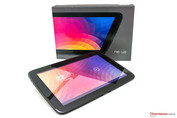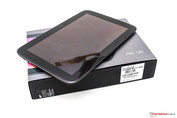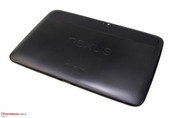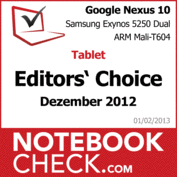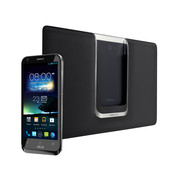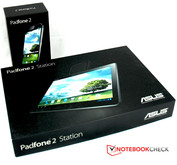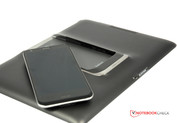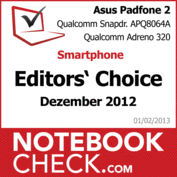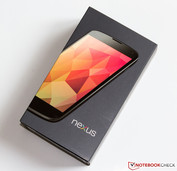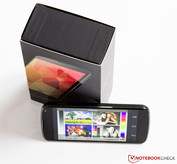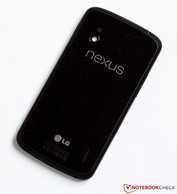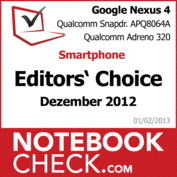Notebookcheck's Best of December 2012 – Smartphone and Tablet Edition
For the original German article, see here.
When Christmas approaches, the demand for tablets and smartphones reaches a new year's high. Our test field reflected this in December. We have rarely ever had so many devices in for review – and among them were some very extraordinary models. This time, Medion's LifeTab S9714, exclusively available at the discounter Aldi, kicked things off. Until now it was always worthwhile to take a look at Aldi's devices. We had the LifeTab in review 3 days before its release. The next, long-awaited tablet whopper followed at its heels in the form of Google's Nexus 10. The search engine giant wants to offer a lot of power for a fair price, as its smaller Nexus 7 already did. One of the most famous tablet manufacturers, Asus, countered this with its very first Windows RT device. Asus' Vivo Tab RT TF600 is actually one of the first Windows RT tablets available on the market. We had another one in for review on New Year's Eve: Samsung's ATIV Tab GT-8510.
The French manufacturer Archos is known for low-priced tablets with clever details. The Archos 101 XS also joins the race with a "keyboard lid". The Unitech TB100 is even more special. This extremely robust tablet can easily cope with the most rugged treatment.
A total of five smartphones were at the starting line in December. Two long-awaited and highly praised in advance novelties, Nokia's Lumia 920 and Google's Nexus 4, were present. Interesting alternatives in the forms of Huawei's Ascend D1 Quad XL and Sony's Xperia T, which secret agent 007 currently relies on, joined in. The hybrid of smartphone and tablet, the unique Asus PadFone 2, finished off December.
Category Tablets
Contenders:
Medion LifeTab S9714 84 %
Google Nexus 10 90 %
Archos 101 XS 82 %
Unitech TB100 85 %
Samsung ATIV Tab GT-P8510 87 %
In early December, a tablet reached us that was to arouse great interest with Medion's LifeTab S9714. The experience with prior models led to this conclusion. Aldi again wanted to lure buyers with a thorough configuration for a fair price. The tablet really does not lack anything in terms of equipment. Medion also includes extensive accessories. Overall, it is a complete package with decent performance. We partly criticized the careless workmanship and the sometimes unreliable touchscreen. The final rating was good, but not outstanding.
In return, Google's Nexus 10 reaped in this verdict in a few sub-disciplines and achieved a rating of 90%. Consequently, it is currently in third place in our Top 10 Tablets. The 10-inch tablet could particularly excel with its brilliant HD screen and the latest Android version 4.2, which Google reserves for company-own devices to date. This was complemented with a meticulous workmanship, long battery runtimes and – even if not part of the rating – a very fair price. We deemed the omitted micro SD slot for memory expansion and the lack of an optionally available 3G module adverse.
We also had high expectations for Asus' Vivo Tab RT TF600, the first Asus tablet powered by Windows RT. The Android brother, Asus Transformer Pad Infinity TF700T, is currently in second place in our Top 10 Tablets. However, the well-built 10-inch tablet just scratches the 90% rating necessary for this. Consequently, it "only" achieved fifth place. Neither the screen nor its handling gave reason for complaint. Its performance was also more than sufficient for everyday use. We were not happy that the USB port could only be used with an adapter cord. The author would also have appreciated a digitizer pen. Nevertheless, an altogether very good tablet.
The Archos 101 XS did not score quite as well. Despite the clever solution with the docking keyboard that is a protective cover at the same time, the 10-inch device "only" achieved a final rating of 82%. Regrettably, there were two quite major points of criticism. The casing could be warped easily and partly resulted in unwanted inputs. Also, the flickering screen was too dark. Consequently, the tablet could not reach a better rating although it is very slim and the keyboard cover was well-implemented.
So far, the only ruggedized tablet that found its way to our test lab came in the form of the Unitech TB100. This device is really special. This was also why we had a hard time with the rating. The innards of the very robust and equally well-built tablet were based on Nvidia's outdated Tegra 2. Google's Android Honeycomb was also almost two years old. But, that was the point of this tablet: reliable technology that works for a long time without modification. In return, the components were carefully selected. In any case, the tablet survived innumerable drops, a shower and the freezer without taking damage and should thus be perfectly suitable for rough treatment, even when remote from civilization. Its performance was only mediocre, the weight and dimensions for a 7-inch device rather high and big.
On time for New Year's Eve, Samsung's ATIV Tab GT-P8510 got the opportunity to ignite a real firework. However, the first Windows RT tablet from the Korean manufacturer did not fully exploit this chance. Its feel and build were high standard and we did not have any criticism on screen, battery life or everyday performance. The enthusiasm was slightly marred by the fact that only 14 GB net of the 32 GB gross memory was left after startup and that a 3G module was not available even for a surcharge, just like the detail that the tablet could only be recharged via a power supply unit. A higher screen resolution should also be possible for a price of 750 Euros (~$980).
Tablet of December 2012: Google Nexus 10
Consequently, the December winner is Google's Nexus 10. The 10-inch Android tablet did not exhibit any major weaknesses and achieved the highest rating. Moreover, the fair price makes it even more attractive.
What we like
The good performance of the incorporated components, the fast Vanilla Android (4.2.1 Jelly Bean) and the stereo speakers' positioning.
What we'd like to see
The option to inexpensively expand the memory using a card reader and a Nexus 10 model featuring a 3G or LTE module.
What surprises us
The given overall bundle around the high-res, 10.1-inch screen featuring a resolution of 2560x1600 pixels at an attractive price. The best Android tablet to date (?)
The competition
The Nexus 10 does not need to fear competition from Samsung. Google's smaller Nexus 7 is the portable counterpart from Asus. Cupertino puts a strong rival into the mix with the iPad 4. Choosing the operating system is a personal preference. New to the battle for the crown are Windows 8 tablets and Microsoft's Surface RT.
Category Smartphone
Contenders:
Asus PadFone 2 87 %
Nokia Lumia 920 86 %
Sony Xperia T 86 %
Google Nexus 4 87 %
A total of five smartphones arrived in our test lab in December. Huawei's Ascend D1 Quad XL was our first guest. It not only makes a somewhat exotic impression because of its name. In contrast to the trend of using bigger screens in increasingly slimmer devices, Huawei takes a different approach. Although the suffix "XL" hints at an especially big screen, the manufacturer is rather restrained here. In return, the device is quite bulky and robust. Furthermore, the bright screen and the potent SoC belong on the pro side. The non-removable battery, the mediocre runtime and weak front-facing camera dismayed us.
Asus sent its second generation "smartlet" into the race. Asus' PadFone 2 has been considerably improved compared with the first generation. It features a high-quality build and now it is even easier to convert from a smartphone to a tablet. However, care should be taken because the smartphone's charging port could quickly take damage – like in our test device. The smartlet's performance was high standard and the (two) screens also mostly convinced us. We deemed the PadFone Station's unprotected ports as a bit unfavorable. Nevertheless, the PadFone 2 achieved a high rating of 87%.
We waited full of anticipation for the Nokia Lumia 2. Finally, we had the second smartphone powered by Windows 8 in review. Last month, HTC's 8X won the Best-of-Award. It was not quite enough for Nokia's Lumia 920 – although it was tight. We discovered many good traits on the Finnish manufacturer's latest flagship. Among other things, the flawless build and the primary camera's high quality. We also liked its handling and performance. However, the screen could have been a bit brighter and the device overall a bit lighter and smaller. A phone should not feature a non-removable battery or lack a card slot either.
James Bond currently makes calls with Sony's Xperia T. Is it a secret weapon? No, but it is a solid smartphone in any case. It particularly excelled with its bright HD screen and its strong "heart". The high-quality build matched to that. However, the non-removable battery, weak cameras and rather outdated Bluetooth 3.0 standard were points of criticism. Nevertheless, Sony's Xperia T did not fall far behind the best "smarties" in December.
The search engine company Google also sent its Nexus 4 into the race and sort of claimed a favored role for itself. The 4.7-inch device fulfilled this role quite well. We praised the high-quality build, the latest operating system and flawless workmanship. Also, Google's smartphone reaped in points with its quite good camera and the option for connecting an HDMI adapter. However, the Nexus 4 did not remain without reproach. We criticized the unreliable Wi-Fi reconnect, the non-removable battery, the lack of a card slot and the rather short warranty period.
Smartphone of December 2012: Asus PadFone 2 and Google Nexus 4
Of the five smartphones, four stepped on the crowded winner's podium in December. At the top and with the same final score, we find the smartphone transformer Asus PadFone 2 and Google's Nexus 4. The distance to the competition is very tight, but that's life.
Shortcut Asus PadFone 2
What we like
The premium design and the smartphone's pleasant feel.
What we'd like to see
Where is the stylus? Was the headset/input device combo a flop?
What surprises us
How sensitive the charging port and connector are. The fragile solution is the PadFone 2's Achilles' heel.
The competition
So far there is only one such hybrid solution on the market, namely, the Asus PadFone 1. The competition comes from the same manufacturer.
Shortcut Google Nexus 4
What we like
The SoC is potent and works well with the generously sized working memory. Bottlenecks are not discovered anywhere.
What we'd like to see
A somewhat better battery life wouldn't hurt in order to compensate for the non-removable lithium-ion battery. A micro SD slot would also fit perfectly in the overall concept.
What surprises us
The performance for money ratio is congruent. Almost every manufacturer can take an example of that. Excellent hardware at an affordable price.
The competition




